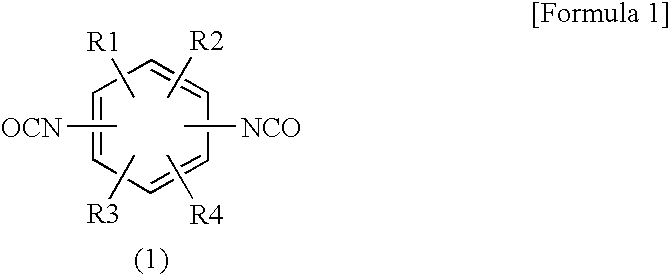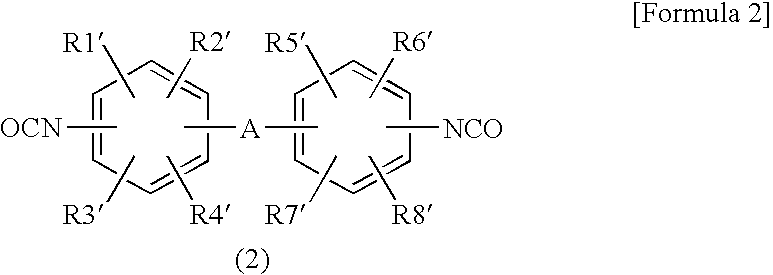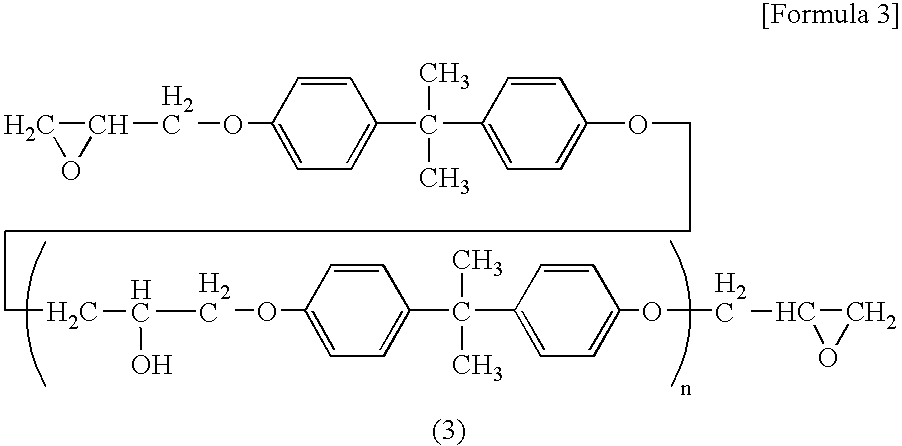Flame-Retardant Epoxy Resin Composition
a flame-retardant epoxy resin and composition technology, which is applied in the direction of synthetic resin layered products, metal layered products, textiles and paper products, etc., can solve the problems of insufficient flame-retardant, heat-retardant, water-retardant adhesion of cured resin, and the possibility of a tiny amount of dioxins forming, etc., to achieve excellent heat-retardant
- Summary
- Abstract
- Description
- Claims
- Application Information
AI Technical Summary
Benefits of technology
Problems solved by technology
Method used
Image
Examples
production example 1
[0072] One hundred parts of bisphenol A epoxy resin (epoxy equivalent 189 g / eq) were charged with 0.04 parts of tetrabutylammonium bromide. The resultant solution was heated under stirring to an internal temperature of 175° C. The solution was further charged over 120 minutes with 16.1 parts of Coronate T-80™ (TDI, manufactured by Nippon Polyurethane Industry Co., Ltd.; approximately 80% 2,4-tolylenediisocyanate, approximately 20% 2,6-tolylenediisocyanate). Once this had been charged, the resultant solution was stirred for 4 hours while maintaining the reaction temperature at 175° C., to thereby obtain the oxazolidone ring-containing epoxy resin I.
production example 2
[0073] One hundred parts of bisphenol A epoxy resin (epoxy equivalent 189 g / eq) were charged with 0.04 parts of tetrabutylammonium bromide. The resultant solution was heated under stirring to an internal temperature of 175° C. The solution was further charged over 120 minutes with 30.9 parts of MR-200™ (diphenylmethane diisocyanate manufactured by Nippon Polyurethane Industry Co., Ltd.). Once this had been charged, the resultant solution was stirred for 4 hours while maintaining the reaction temperature at 175° C., to thereby obtain the oxazolidone ring-containing epoxy resin II.
[0074] The characteristics of the oxazolidone ring-containing epoxy resins I and II are shown in Table 1. In Table 1, “n=0 component” means the unreacted monomer component in the raw material bisphenol A type epoxy resin.
production example 3
[0075] A 2-liter, four-necked flask equipped with a reflux condenser, a thermometer, a stirrer and a dropping funnel was charged with 116 g of a mixture consisting of hexachlorocyclotriphosphazene and octachlorocyclotetraphosphazene (82% hexachlorocyclotriphosphazene and 18% octachlorocyclotetraphosphazene) (1 unit mole, wherein NPCl2 serves as 1 unit) and 200 ml of THF, to thereby obtain a solution. Next, a separately-prepared solution of a sodium salt of 4-methoxyphenol in THF (126.5 g of 4-methoxyphenol (1.1 mole), 23 g of sodium (1 g-atom) and 400 ml of tetrahyfrofuran) was dropped over 1 hour while stirring into the above-described solution of hexachlorocyclotriphosphazene in THF. Since the resulting reaction vigorously generated heat, the reaction was carried out by appropriately cooling so that the reaction temperature did not exceed 30° C. After dropping was finished, the reaction was continued under stirring for another 6 hours at 60° C.
[0076] The amount of partially subst...
PUM
| Property | Measurement | Unit |
|---|---|---|
| Fraction | aaaaa | aaaaa |
| Fraction | aaaaa | aaaaa |
| Fraction | aaaaa | aaaaa |
Abstract
Description
Claims
Application Information
 Login to View More
Login to View More - R&D
- Intellectual Property
- Life Sciences
- Materials
- Tech Scout
- Unparalleled Data Quality
- Higher Quality Content
- 60% Fewer Hallucinations
Browse by: Latest US Patents, China's latest patents, Technical Efficacy Thesaurus, Application Domain, Technology Topic, Popular Technical Reports.
© 2025 PatSnap. All rights reserved.Legal|Privacy policy|Modern Slavery Act Transparency Statement|Sitemap|About US| Contact US: help@patsnap.com



